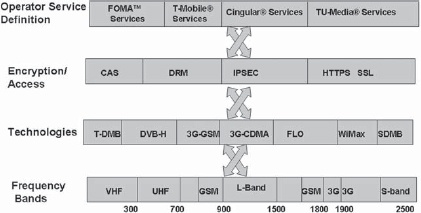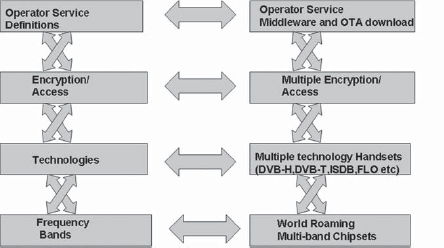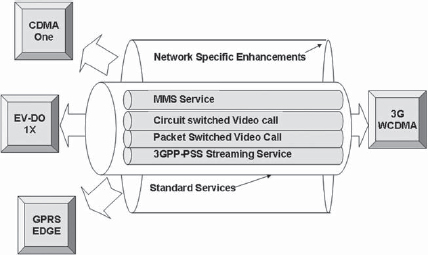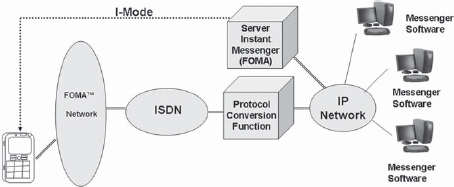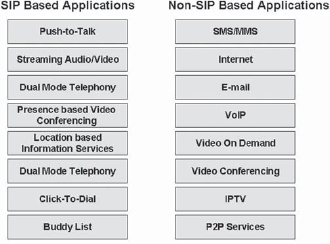MOBILE TV AND MULTIMEDIA SERVICES INTEROPERABILITY
Everything has been said before, but since nobody listens we have to keep going back and beginning all over again.
—Andre Gide
We are in the early days of mobile TV and video calling. But Internet access, browsing, video and audio file downloads, MMS, and other multimedia applications are now being used extensively. Video calling and 3G mobile TV services are available in many networks across countries, but their usage at present is minimal and will grow over time with the universal availability of handsets. One of the key factors in the widespread growth of the mobile multimedia services and mobile TV will be the capability of these services to be usable across multiple networks. This aspect has been drawing the attention of the industry players, including standards organizations, operators, handset manufacturers, and application designers. The players also realize that we are in a bipolar world of CDMA- and GSM-evolved 3G networks and coordination is necessary to impart network interoperability, roaming, and porting of applications. The industry is putting in considerable resources toward an early harmonization of standards and services.
This chapter gives an introduction to the principles on which roaming and network interoperability will be built in IMT2000 networks for multimedia and mobile TV services.
Interoperability is a multidimensional issue. At the turn of the century, in the Year 2000, most of the world was basking in the glow of mobile interoperability. The GSM mobile networks, which had spread by now to all continents, including the Far East, Asia, South America, and Africa, in addition to the whole of the United States and Europe, now provided seamless roaming. Apart from the networks, which were interoperable, the commercial arrangements had also fallen into place and testing completed to enable customers to roam seamlessly. This was so at least in the GSM world.
Large domains of customers that were covered by the CDMA networks, however, had only limited interoperability. Even though many countries such as the United States, Japan, Korea, and India had a large base of mobile customers based on CDMA, interoperability and roaming remained out of reach, owing to different bands of operation, differences in the CDMA technologies themselves, and nonavailability of sufficient roaming arrangements.
In the United States the situation was nothing short of a functioning anarchy. Many networks were still analog and those that had moved to the digital technologies had used time division multiple access (TDMA) -based networks, which did not interface with the GSM owing to differences in technologies and air interfaces. Moreover, the frequency bands that had been agreed on for GSM globally were occupied by analog, TDMA, or CDMA systems. It was indeed difficult to roam seamlessly across the United States, let alone globally.
By 2002, networks had started rolling out for 3G services based on GSM as well as CDMA. The FOMA network in Japan demonstrated the power and commercial viability of 3G services by virtue of its user interfaces and menus, which rode on top of the technology to make the network offerings friendly and user-centric rather than technology-centric. At the same time developments continued in the GSM and CDMA worlds under the Third Generation Partnership Project (3GPP) and 3GPP2 partnership fora to deliver advanced services that could be globally implemented by building on a base of common standards and protocols (e.g., 3GPP, 3GPP2, H.364-M, and Session Initiation Protocol (SIP)). These attempted to standardize all elements involved in setting up a multimedia call, such as file definitions, call setup, and information delivery mechanisms as well as interoperability, by defining common base-level standards that needed to be supported in all networks, with only the enhancements in features being optional. This did work out quite well for the individual 3G or GSM networks and CDMA networks. There was a clear recognition, and an objective before all groups coordinating the developments, that it is interoperability and roaming alone that can lead to greater penetration of devices and networks. No one wished a situation like that of the early days of GSM/CDMA networks to arise.
The launch of new broadcast-oriented mobile TV networks has now added another dimension since 2004. The new networks are based on technologies such as DVB-H, DMB, 3G, FLO, and various others such as ISDB-T. The launches were constrained to be in different bands and with differing technologies. The true dimensions of interoperability were now obvious to everyone. True interoperability involved harmonizing the base technologies, internationally coordinated frequency bands, conditional access or digital rights management, and service personalization in various networks. Multimedia and mobile video and audio, as we have seen, can mean a very wide spectrum of services and whether these can (or should) work interoperably with all other networks is a major issue for consideration. For example, mobile video telephony and live video streaming services have been defined as standards; can this be taken further? Can an e-mail service with animated facial expressions become an international standard? Or can push-to-talk be taken as a common feature across networks? One way to overcome the country- and operator-specific issues is that of multiple standard support in handsets, though this is not true interoperability. There could be interoperability only if the parameters could be coordinated sufficiently so all devices support the same standards across networks (Fig. 9-1).
Bodies such as the Open Mobile Alliance (OMA) have been concerned with these developments sufficiently so as to come out in support of features that would enable interoperability of networks, devices, and services. The support of DVB-H BCAST based on open standards by OMA was in fact seen as a step in this direction.
FIGURE 9-1 Dimensions of Mobile Interoperability
The response of the mobile world—standards bodies, country regulators, operators, handset manufacturers, and others, has been equally broad-based and multidimensional.
Even China, known in the past for its proprietary technologies, has announced support of mLinux, an open embedded operating system for phones, and technology collaboration for 3G (TD-SCDMA) and already supports roaming for business travelers between Korea, Japan, China, and the United States. However, it is still looking at divergent technologies in the DMB arena, a fact that continues to worry the industry.
Industry efforts at interoperability include the chip set makers, who have in the past promoted the use of global roaming chip sets for various frequency bands, and handset makers with dual-mode 3G-GSM and CDMA2000 1× and 1× EV-DO phones, which can roam globally; multistandard tuners for all the broadcast mobile TV transmissions; and middleware for service characterization. Middleware also helps to select and launch the appropriate DRM systems and services on handsets that track the services offered by particular networks. Interoperability for voice networks is now a reality in large parts of the world.
This should not, however, suggest that we are there yet in terms of interoperability. In fact true interoperability and roaming for multimedia services and roaming are quite distant on the horizon. There is a concerted effort in the industry to usher in interoperability. We look at some of these efforts and preview some real-life networks in terms of interoperability (Fig. 9-2).
FIGURE 9-2 Moving Toward an Interoperable Environment
Interoperability is of interest to users as well as handset manufacturers. Users, for example, may like to be able to have a video conference with or make video call to users who may be on other networks. The handset manufacturers need to be able to have standard devices that will work in various networks and not have to be designed for specific networks, which does not allow the same economies of scale.
9.2 ORGANIZATIONS FOR THE ADVANCEMENT OF INTEROPERABILITY
9.2.1 3GPP and 3GPP2
The Third Generation Partnership Project (www.3gpp.org) is a collaboration agreement between a number of telecommunications standards bodies, including ARIB, CCSA, ETSI, ATIS, TTA, and TTC. 3GPP was set up in 1998 with the goal of providing globally applicable technical specifications for a third generation mobile system based on GSM-evolved technologies, including GPRS, EDGE, and 3G (UTRA). 3GPP developed the IMS (IP Multimedia System) in 3GPP release 5, which provides the framework for the 3G networks, protocols, and standards for interworking. The IMS provides the framework for the IP-based multimedia services and the packet-switched domain.
3GPP2 (Third Generation Partnership Project 2) is also a collaborative agreement between standards development organizations, including ARIB, TTSA, TIA, TTC, and TTA, for development of standards for 3G-evolved networks based on CDMA technologies (ANSI-41 core networks). It also has the CDMA Development Group (CDG) and IPv6 forum as its members. 3GPP2 has come out with the MMD as the framework of specifications, protocols, and standards for interworking.
9.2.2 International Multimedia Telecommunications Consortium (IMTC)
The IMTC is a not-for-profit organization (business league), which was set up in 1993 with an open membership policy to promote the development of interoperable multimedia products based on standards. The objective is to have international standards that span across the networks and technologies to provide interoperable services for multimedia. In addition to the above, it aims to provide increased compatibility in rich media products and services. Having better compatibility in multimedia products and more standards that can be applied globally will shorten the time span for conception and introduction of new multimedia services and increase their usability penetration and acceptance.
9.2.3 Open Mobile Alliance
The OMA is an industry organization with a wide partnership of mobile handset manufacturers, operators, etc., with a mission to provide open standards based interoperable mobile services across the world. The agreement on the open standard MMS version 1.2 is an example of the cooperation between operator groups such as the GSM association and the CDG that was carried out under the aegis of the OMA.
9.3 NETWORK INTEROPERABILITY AND ROAMING
It is important to understand the difference between network interoperability and roaming. Under the 3GPP–IMS roaming is defined in two forms. In the first type of roaming the user terminal uses the IMS in the home network. This means that the user terminal uses the resources of the visited public land mobile network (VPLMN) to connect to the IMS core network that resides in the user’s home network (HPLMN). This means that the user is always connected to the home network for all resources via the IP facilities of the visited network, which in fact functionally provides a tunnel to the home network. Other functions such as charging are done in the home network for the resources used in the IMS home core network (Fig. 9-3).
SK Telecom introduced the WCDMA automatic global roaming service in cooperation with Vodafone K.K. of Japan in June 2005. Using this service customers of SK Telecom could roam in Japan and make video telephony calls using the same handset as was used in Korea (Samsung W120). The service was later extended worldwide, including Hong Kong, Singapore, Italy, The Netherlands, the United Kingdom, and Germany. A menu is provided in the handsets, which enables them to receive the local WCDMA provider’s frequency. Similarly roaming was also demonstrated by Korea Telecom’s 3G operator Kitcom with J-Phone (now Vodafone) and others. Vodafone complemented the offering with V801SH, which offered roaming in all 3G WCDMA, GSM, and GPRS networks.

FIGURE 9-3 Roaming in 3GPP IMS Networks. GGSN, Gateway GPRS switching node (edge routing); SGSN, Serving GPRS support node (tracking the mobile station); P-CSCF, proxy call session control function; S-CSCF, serving call session control function; HSS, home subscriber server
In Europe Vodafone launched Vodafone Live! services with roaming agreements among a number of countries.
In the second type of roaming the terminal uses the IMS of the visited network. In this case the terminal will be assigned the IP number and all resources from the visited network. It is likely that all roaming in the initial phase will be of the first type, i.e., involving the use of the home IMS.
Internetworking in the IMS framework means that the two IMS networks (home and visited networks) are connected via network packet resources through an inter-PLMN IP network. The two user terminals set up sessions using SIP, which involves the two IMSs, while the user traffic flows directly using the GGSNs (the IMS Roaming and Interworking Guidelines 3.5 were issued by the 3GPP in August 2006 in document IR.65) (Fig. 9-4).

FIGURE 9-4 Interworking in 3GPP Networks. I-CSCF, interrogating call session control function; BG, border gateway.
Roaming among 3GPP networks is now fairly well established. The use of common radio interfaces, availability of multiple band handsets, and the commercial arrangements between different networks are now extending roaming, which is firmly in place for voice services, to multimedia services.
9.4.1 3GPP Networks—FOMA
The world’s first 3G network was launched by NTT DoCoMo in 2001 in Tokyo. FOMA was a portfolio of voice, data, and multimedia services that were delivered using the 3G network. NTT DoCoMo’s use of 3G was based on WCDMA as standardized by ARIB and in the frequency bands 1920–1980 and 2110–2170 MHz. Video calling, packet-switched data. and MMS were some of the services introduced by NTT DoCoMo in its network.
In 2002 J-Phone in Japan also launched its 3G services based on the Vodafone Global Standard. Both services were based on 3G-324M but initially interworking was not possible due to different implementations of the standard. This meant that subscribers to FOMA and J-Phone could place video calls within their networks but a FOMA subscriber could not call a J-Phone subscriber with a video call and vice versa. Interworking tests were conducted in 2003 to establish interconnectivity.
Interoperability within the 3GPP networks is now fairly common. As far back as 2004, FOMA customers in Japan could make video calls to 3 in the United Kingdom and 3HK in Hong Kong and NTT DoCoMo under its World Call videophone services and Data Call (64K) services. By 2005 FOMA interconnectivity under World Call had spread to over 13 countries, which included countries in Europe, Asia, and North America.
9.4.2 3GPP2 Networks
3GPP2 networks today are characterized by data services, video streaming, audio, and games. As 1×EV-DO is essentially an overlay network for data, 300–700 kbps of data rates can be delivered to a user and roaming is possible for data calls. For voice calls the network still reverts to CDMA 1×RTT and hence services such as video calls are not common.
The 1×EV-DO networks have now been widely deployed in the United States (Verizon and Sprint Wireless), Canada (Bell Mobility), Japan (KDDI), and Korea (SK Telecom and KT Freetel), in addition to other countries such as Brazil, Mexico, Australia, and New Zealand. Roaming services of both voice (1×RTT) and data (1×EV-DO) are available between Sprint, Alltel (United States), and Bell Mobility (Canada). The Sprint 1×EV-DO services are available under Sprint Power Vision, which includes Sprint TV, music, games, video mail, etc. Similarly KDDI offers roaming (including data roaming to South Korea, China, and North America).
9.4.3 Roaming between 3GPP and 3GPP2 Networks
3GPP and 3GPP2 have defined the air interfaces, protocols, and codec standards for 3G-GSM-evolved networks and 3G-CDMA-based (CDMA2000 1×, 1×EV-DO) networks. There have been considerable developments in evolving common ground, such as agreement on IP-based core networks, support of IPv6, and protocols for call setup and release. In the 3GPP forum release 6 specifies the operation of the 3GPP Packet-Switched Streaming Service (3GPP-PSS release 6), while in the 3GPP2 it is addressed under Multimedia Streaming Services. Both standards have achieved considerable harmonization as can be seen from the use of the standards. However, this does not imply that we have achieved interoperability in multimedia services and mobile TV.
First of all, even though there are standards prescribed by 3GPP and 3GPP2 for audio and video coding, they are not identical. This implies that the handset design needs multiple players and the necessary intelligence to launch the players for the appropriate video or audio file type. As an example, Table 9-1 shows that the file formats for the two systems represent persisting differences.
Second, there are variations based on implementation. For example, the standards for packet-switched streaming service are different for 3GPP, 3GPP2, Korean Standard for Streaming (KWISF), Japan (i-mode progressive download/streaming), and China (Unicom).
Features Support in 3GPP and 3GPP2
| Feature | 3GPP | 3GPP2 |
| Video codec support | H.263, MPEG-4 (visual simple profile), optional | H.264 |
| Support for audio (music) | MPEG-4/AAC-LC (optional) | AAC + |
| Speech codec | AMR-WB | QCELP 13K, EVRC |
This implies that the handset needs to use a player that can function on the streaming in multiple standards. The use of such a player is to have interoperability in multiple network environments.
9.4.4 IP Networks
By virtue of the fact that the mobile networks now provide access to high-speed Internet as well as having core networks based on IP, the delivery of multimedia services based on IP is gathering considerable attention. This includes “out of band IP” delivered by networks such as WiMAX. Applications are emerging that can deliver multimedia and mobile TV services based on IP connectivity.
An example of an IP-based video phone service is the Streamphone 2.0 wireless video call service. The service can work on any IP network, such as Wi-Fi, WiMAX, EV-DO, or landline Internet services. Handsets are available that can receive WiMAX (e.g., Samsung i730 Pocket PC and Samsung M800 WiMAX and WiBro phones). Video call services can be used seamlessly from any network in the world providing IP or from a place where access to WiMAX is available.
The Streamphone 2.0 service has been tested over the Verizon 1×EV-DO network.
9.4.5 Frequency Issues
Mobile services based on different standards have historically been placed in a number of different frequency bands. Despite significant global alignment after the adoption of GSM bands of 900, 1800, and 1900 MHz, there are services in other bands, including 850, 450, and 800 MHz. Fortunately, world roaming chip sets are now available, which can provide selection of any frequency band. Frequency issues, while important, take second stage to harmonization of protocols, codecs, and services for multimedia.
9.4.6 Network Interoperability
The basic question that needs to be answered is whether commonly used voice, messaging, and multimedia services will remain interoperable. For example, can a video call be made between a FOMA phone and a Cingular 3G phone? Or can an MMS be sent and delivered successfully from one network type to another? If so in which networks and what are the limitations?
The issue of interoperability needs to be classified under:
1. interoperability between 3GPP networks and between 3GPP2 networks as separate groups and
2. interoperability between the 3GPP and the 3GPP2 networks.
The guidelines for video telephony interoperability (Video Telephony Circuit-Switched Video Telephony Guidelines version 1.0) were issued by the 3GPP in June 2005 in IR.38.
The document provides complete guidelines including codec standards, call setup, multiplexing protocols, media exchange, and internetwork protocols and roaming guidelines for calls to be set up in accordance with 3G-324M standards (Fig. 9-5).
A number of interoperability tests have been conducted under the aegis of the IMTC, such as interoperability testing for:
• H.323 (video conferencing services),
• 3G-324M (video calls with circuit-switched bearers),
• 3G-PSS (packet-switched streaming services),
• SIP (session initiation protocol or call set up),
• voice over IP,
• T.120 (data conferencing or NetMeeting), and
• H.320 (videoconferencing over IP).
FIGURE 9-5 Internetworking—3GPP and 3GPP2 Networks
Table 9-2 shows the status of the operation of multimedia services over 3G and evolved networks. Voice, data, SMS, and MMS service can today be seamlessly delivered across networks using both CDMA and 3G-GSM.
It is evident that interoperability between 3GPP and 3GPP2 networks still has a long way to go before it can be deployed widely in commercial networks.
9.5 INTEROPERABILITY OF MULTIMEDIA SERVICES
9.5.1 Messaging Interoperability—MMS
In November 2003 the OMA announced standards for MMS, i.e., MMS 1.2, which were a major step in taking the industry toward interoperability. MMS is an important service and can carry multimedia content including video and audio files and video clips. The MMS version 1.2 specifications define the minimum requirements and conformance to enable end-to-end interoperability. The effort was the culmination of long-ranging efforts between 3GPP and 3GPP2 for various protocol levels involved in MMS services.
Status of Operation of Multimedia Services in 3G Networks
| Multimedia service | 3GPP | 3GPP2 |
| Circuit-switched video telephony 3G-324M or H.324 with mobile extensions | Available from all major 3G UMTS operators based on standards | Limited availability |
| MMS service, MMS version 1.2 | Widely available and deployed | Widely available and deployed |
| 3G-PSS point-to-point streaming services (based on RTSP) | Available with H.263/H.264 or MPEG-4 codec support | Available with H.263/H.264 or MPEG-4 codec support |
| Packet-switched video telephony (RTP based) | Under implementation in networks (based on 3GPP release 4) | No decision on codecs in 3GPP2 |
| 3G broadcast services | Will be available (MBMS) | Will be available (MCBCS) |
| MBMS or MCBCS | Available in Release 6 (MBMS) | Will be available (MCBCS) |
| Multicast file transfer (FLUTE) | Available in Release 6 (MBMS) | Will be available (MCBCS) |
| Multicast streaming | Available in Release 6 (MBMS) | Will be available (MCBCS) |
9.5.2 3G-324M
The 3G-324M standard is the standard for circuit-switched video telephony, streaming and other services based on underlying reliable circuit-switched network architecture (or IP network emulating circuit switching). The 3G extension to the H.324 standard provides for the codec types that can be used in mobile networks and protocols for call setup and release. Being a stable standard, the initial releases of video calls have been based on the 3G-324M standards. It is possible to place these calls from land-based or mobile terminals and vice versa. Most of the 3G networks today provide video calls using 3G-324M and its enhancements.
Network-specific enhancements are required in 3G-324 M because 3G-324M does not deal with the call setup or termination process. The call setup and release are handled by the mobile network’s radio interface as a layer above the circuit-switched services provided by the 3G-324M. The features are therefore network specific and features such as call forwarding and roaming to SS7 networks are not supported.
In the case of a video call to a user handset that does not support video or is outside the roaming area where such calls are possible the call may simply disconnect. Enhanced Internet work features are needed to support establishment of a simple voice call in case video calls are not supported. These are now available in many networks.
9.5.3 Video Conferencing (H.323)
H.323 is an ITU standard for audiovisual conferencing. H.323 video conference standards have been in use for a long time over packet-switched and IP networks for both fixed and mobile usage. Internet applications such as NetMeeting use the H.323 protocol. The support of the videoconference function is required in mobile networks for Internet to mobile phone interworking.
The FOMA network in Japan, for example, uses a protocol conversion function (developed by NTT DoCoMo) for conversion between H.323 on the IP network and 3G-324M on the mobile network. For video calls the communications pass through ISDN from the FOMA network, which provides bearer-based video calls for FOMA subscribers who use the 3GPP 3G-324M protocol. A protocol conversion function presents the video service in the form of H.323 to the IP-based video terminals. The protocol conversion provides full interoperability (Fig. 9-6).
For messaging applications the Instant Messenger developed by NTT DoCoMo supports dual protocols, i.e., SIP and H.323. The PCs communicate using SIP, and the H.323 communications to FOMA are converted and delivered to the handsets, which use an i-Appli downloaded software. The protocol conversion function SIP/H.323 ensures compatibility.
9.5.4 SIP
The initial implementation of video calls in 3GPP networks was based largely on the 3G-324M technologies, as these standards have been stable for some time and the codecs for them have been agreed upon in both 3GPP and 3GPP2 as well as in the fixed lines circuit-switching domain. The SIP technologies are now bringing a transformation to the use of video phones. Extensions of SIP, i.e., “instant messaging” and “presence” (sometimes called “simple”), are now being widely implemented in both mobile and IP networks. SIP, being based on IP technology, provides a medium for providing new services such as voice over IP (VoIP) and instant messaging. SIP clients are available on mobile phones, which helps implement the applications based on SIP. The implementation of IP-based protocols through clients that use the underlying IP layer enables the provision of services such as:
FIGURE 9-6 H.323 Functions in the FOMA Network
• push-to-talk,
• presence,
• instant messaging,
• VoIP,
• IP-based video calling,
• clip streaming and download.
As an example Verizon Wireless operates the 1×EV-DO network in the United States. It has embraced the use of the IMS for the provision of SIP-based services, which it calls “advanced IMS” or A-IMS. The advanced IMS provides a number of innovative SIP-based services (Fig. 9-7).
The implementation by Verizon of the A-IMS standards is a recognition of the fact that SIP-based services for mobile networks need extensions to take care of security, loss of signal while roaming, and a variable bit rate environment. Correspondingly the applications need to be able to deal with these events.
FIGURE 9-7 Verizon Wireless Advanced IMS Services (Source: Verizon Wireless)
9.5.5 Packet-Switched Streaming Services—Mobile TV
PSS require a number of features to be supported. These include:
• streaming bit rate adaptation,
• progressive download (H.264 video and AAC+ audio),
• multitrack signaling.
This requires that devices such as encoders at one end and decoders on the other be protocol compliant and parameter compliant. The PSS Activity Group of the IMTC is responsible for interoperability of devices and networks and their testing. Trials were conducted by the GSM association for global interoperability using SIP and IMS interworking with over 24 operators of 3G services taking part. Video share trials, in which users can send video clips while on video calls, have also been conducted for global availability of the services.
The availability of 3G streaming services is quite common in 3GPP as well as 3GPP2 networks (i.e., 1×EV-DO). Most of the 3G carriers offer services for streaming of video clips or music. These services can be taken advantage of while roaming to other networks through IP connections to the home IMS. The availability of these services is also dependent on the handset type, which should have global roaming capabilities.
9.5.6 Mobile TV Using DVB-H, ISDB-T, and Other Broadcast Technologies
Mobile TV using broadcast technologies is being operated in various countries using different bands for transmission and different technologies. For example, Modeo (formerly Crown Castle) is offering its DVB-H services using the L-Band. It uses Windows Media technology as the basic technology for delivery of video and audio and its phones support the corresponding players. In contrast DVB-H in Europe is offered using the UHF band and having the codecs as per DVB-H, i.e., H.264 and MPEG-4 visual simple profiles.
The reception of mobile TV using broadcast technologies is essentially a matter of:
• having the right type of handset that supports the appropriate frequency band tuners so as to tune to the local transmissions and 3G systems,
• having the rights for reception through the encryption system or digital rights management system, and
• having a flexible mix of media players for playing video and audio clips, live TV, and radio transmissions.
9.5.7 Mobile TV Based on MBMS Broadcast Technology
3GPP release 6 provides for multimedia broadcast and multicast services for mobile TV. This makes it possible to multicast a number of TV channels for mobiles using unidirectional unpaired 3G spectrum.
Orange in Europe has announced the launch of services based on MBMS using 5 MHz of unpaired spectrum in the 1.9-GHz band using TD-CDMA technology. This permits bundling of up to 17 channels of QVGA resolution in 5 MHz bandwidth. The service (TDtv) uses technology from IPWireless.
9.6 HANDSET FEATURES FOR ROAMING AND INTEROPERABLE NETWORKS
Handsets for various services and features are discussed in detail in Chap. 13. An example of the type of features needed in the handsets can be seen from the product features of a solutions provider for mobile TV—Nextreaming.
Handsets with a Nextreaming embedded application for live TV have been widely used in Korea’s satellite and terrestrial DMB services and its media players have been used in DVB-H services launched by Telecom Italia and 3 Italia in Europe. Nextreaming players have also been used in SK Telecom’s EV-DO network, for which, in addition to the standard players such as MP3, the handsets also support SK Telecom’s PMP.
The live TV application from Nextreaming is known as NexTV, which provides an embedded solution for live TV broadcasting on a mobile phone. The application provides for optimized video and audio decoders (H.264 and HE/AAC and BSAC), image encoders and decoders (JPEG), and processing functions for handling video at fps using QVGA resolution. It can be ported on various CDMA or OFDM chips and multimedia processors (Fig. 9-8).
Nextreaming players and live TV applications have found use in over 31 phones such as Samsung SGH-P920 (for 3 Italy 3G/EDGE and GPRS and DVB-H), Mitac MioC810 (Korean T-DMB), and Pantech IM-U100 for SK Telecom’s EV-DO network. Its NexPlayer application is a video and audio player application that is fully compliant with 3GPP and 3GPP2 standards and supports application-specific enhancements from major operators such as Japan’s i-mode and Korea’s SK Telecom. It supports both CDMA and 3G-GSM networks and provides EVRC, G.723.1 decoders (CDMA), AMR-NB (3GPP), and MP3, AAC-LC/HE, aacPlus, etc., codecs for audio. Video codec support is equally wide to include MPEG4, H.263, and H.264 video decoders.
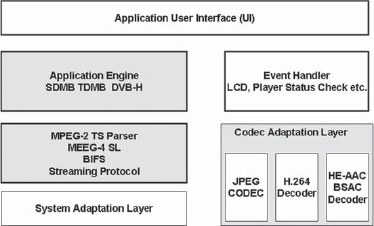
FIGURE 9-8 NexTV Architecture (NexTV is a copyrighted product of Nextreaming)
The application supports the latest features such as 3GPP release 5-compliant local/progressive download and streaming, 3GPP2 local/progressive download and streaming, and also streaming formats for i-mode, SK Telecom, KWISF, China Unicom, and others. NexPlayer has been deployed in a number of handsets such as Pantech Hero used in Helio (SK Telecom and Earthlink EV-DO network), Samsung SGH-P910 (3 Italia), SGH-E-770 (3G networks in Europe), SGH E-770 (Orange France), and others.
Interoperability and roaming in multimedia services such as video calls, streaming services, and live TV has been accepted as a very important criterion for widespread use of the services that are being delivered today from advanced IMT-2000 networks. Efforts to increase interoperability of networks and services, roaming, and universal use of handsets are clear goals before the industry. Coordinated work is proceeding in multiple fora such as 3GPP, 3GPP2, IMTC, ITU, and OMA to ensure better compatibility in multimedia services. Interoperability and roaming are now becoming a reality in 3GPP networks and to an extent in 3GPP2-CDMA networks. However, it will be some time before we are able to reach standards of interoperability and roaming that are now available for voice services.

